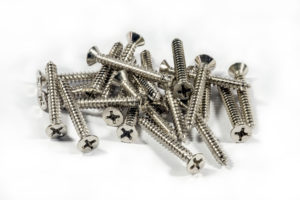 We’ve talked a lot about the various types of custom screw options that we have available, from our micro screws to our custom shoulder bolts. But one topic that has never been discussed is how we create these tools, or how screws are created in general.
We’ve talked a lot about the various types of custom screw options that we have available, from our micro screws to our custom shoulder bolts. But one topic that has never been discussed is how we create these tools, or how screws are created in general.
Check out our EZ Screw Builder to build your custom screw!
Creating a custom screw the size of a micro screw, or a strong and durable Delta PT screw (which has up to 50% improved torsional and tensile strength) might seem very difficult. However, the truth may surprise you. Creating screws is not all that complicated with the right tools. But before we start talking about custom screws or delta screws, we need to cover the basics.
How Are Screws Made?: Starting Out
Screws are generally made from low to medium carbon steel wire, though this material can be substituted for other inexpensive metals, such as brass, nickel alloys, and an aluminum alloy. The quality of the metal, however, must be high to avoid cracking and breaking in the screw.
If there is a finish applied to the screw, it needs to be of a compatible makeup. Steel can be coated in zinc, cadmium, nickel, or chromium for extra strength and protection.
The Manufacturing Process: Basics
How are screws manufactured? Using a variety of methods, and smaller screws or screws with unique designs can only be made by the “machining” process. The machining process is exact, time-consuming, and more expensive than the process to make other screw types. The bulk of all screws are made with the “thread-rolling” method, the method used in mass-production.
We’ll start with thread-rolling.
Thread Rolling
The process starts with “cold-heading,” in which a wire is fed through a pre-straightening machine. The straightened wire is then cut into designated lengths, and then the head is cut into a preprogrammed shape. This is how screws get their many variations in their heads, and the machine can produce 100 to 550 screw blanks in a minute.
After this is done the blank screws are fed to thread-cutting machines, being correctly ordered to make sure they’re in the right position to be fed in. They are then cut in a variety of ways to give them the thread that you see on a screw. This can take two to three rounds or trips through a machine before the desired thread is created.
Machining: Custom Screws
The process for a custom screw is very similar in that it has a lot of the same principles, only it requires more expensive machinery in order to screw the variations in screws. They must be very exact to screw a micro screw, for example, or calibrated differently to create a custom shoulder bolt. The thread-cutting and head creation process is very similar to a traditional screw but requires a more precise machine.
It is because of this precision that the process can take so long.
While you now know the basics on how screw manufacturing works, there is a lot more to it than this. Hopefully, you have a general idea of the process and how we create our custom screws. They’re specially designed for your project and take a lot of time to be that way.

 We’ve talked a lot about the various types of custom screw options that we have available, from our micro screws to our custom shoulder bolts. But one topic that has never been discussed is how we create these tools, or how screws are created in general.
We’ve talked a lot about the various types of custom screw options that we have available, from our micro screws to our custom shoulder bolts. But one topic that has never been discussed is how we create these tools, or how screws are created in general.